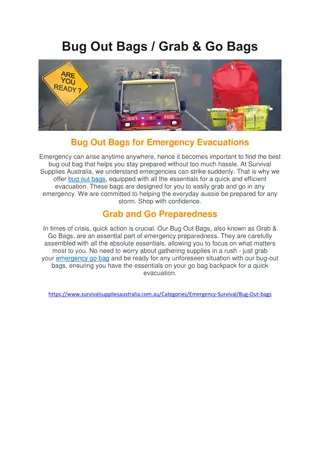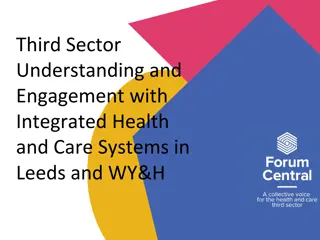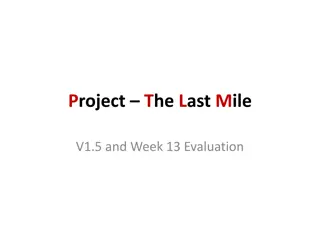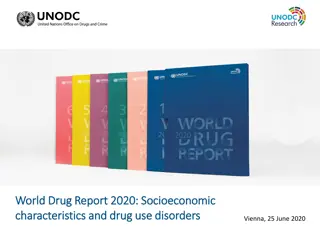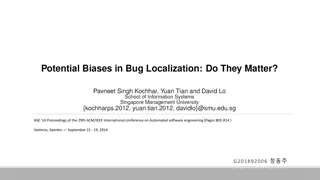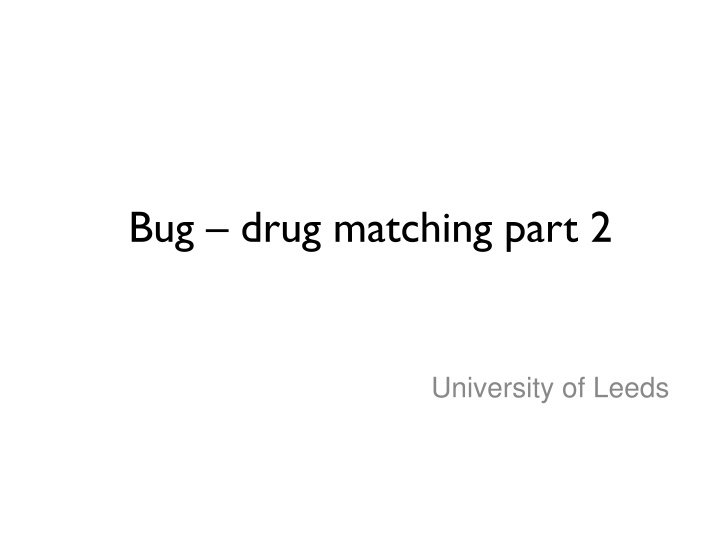
Managing Patients with Infections: Antibiotic Choices & Case Scenarios
Learn how to manage patients with infections, including antibiotic-resistant strains, by understanding the process of selecting antibiotics. Explore case scenarios to gain insight into the treatment of various infections and the considerations involved in choosing the appropriate antibiotics.
Download Presentation

Please find below an Image/Link to download the presentation.
The content on the website is provided AS IS for your information and personal use only. It may not be sold, licensed, or shared on other websites without obtaining consent from the author. If you encounter any issues during the download, it is possible that the publisher has removed the file from their server.
You are allowed to download the files provided on this website for personal or commercial use, subject to the condition that they are used lawfully. All files are the property of their respective owners.
The content on the website is provided AS IS for your information and personal use only. It may not be sold, licensed, or shared on other websites without obtaining consent from the author.
E N D
Presentation Transcript
Bug drug matching part 2 University of Leeds
Objectives To be able to manage patients with infections, including antibiotic resistant infections, by bringing together knowledge from lectures on: Pathogens Infections Diagnostic tests Antibiotics
Antibiotic choices-a note What we would all like To be able to learn a single answer The treatment for pneumonia is amoxicillin and clarithromycin But is it necessary- Guidelines will tell you what to do for a standard patient What reality is Often need to individualise antibiotic choices because Allergy: 10% of patients can t have penicillin's Elderly: Avoid some drugs e.g. ciprofloxacin, with a high risk for Clostridium difficile infection Some patients can t take oral antibiotics Some patients can t take IV antibiotics Some patients have renal impairment-avoid nephrotoxic drugs Microbiology culture results may allow narrowing of the spectrum of antibiotics Microbiology culture results may dictate a new antibiotic choice (resistance) Don t want to exacerbate problems e.g. a patient with diarrhoea might not like to be given a macrolide/prokinetic Some antibiotics interact with drugs a patient is already on e.g. warfarin When should you be able to do the matching process by Somewhere between foundation years training and before or during being a consultant At the moment success will be to understand the concepts of how to treat bacteria with antibiotics
Lecture structure Case scenarios Intended to show you the process a microbiologist undertakes when managing a patient with infection Intended to give you insight into this process Not expected at this point you can do this yourself. A surgical analogy: you might observe an operation, but not expect to perform the operation. Benefits: Know what a microbiologist offers Know how to communicate with a microbiologist Start to learn how to be effective by imitation
Case scenario 1 A patient is admitted to a medical assessment unit in Leeds after being seen by a GP. The GP referral is brief, and asks you to see a 75 year old man who has symptoms of confusion and shortness of breath and signs of fever and tachypnoea.
Before seeing the patient Before you see the patient you take a moment to think about what could be wrong with the patient. As the patient has a fever you think about infections. What are the possible causes of infection in this patient? .
What are the possible causes of infection in this patient?
To make decisions we must deal with the probable
What are the probable causes of infection in this patient? Lecture/System Clinical diagnoses Cellulitis Necrotising fasciitis Fourniers gangrene Infected ulcer Orbital cellulitis Pilonidal abscess Diabetic foot infection Osteomyelitis Septic arthritis Prosthetic joint infections Endocarditis Mycotic aneurysm Infected deep vein thrombosis Central venous catheter (CVC) infections Bacterial meningitis Encephalitis Brain abscess TB meningitis Lecture/System Clinical diagnoses Pyelonephritis Renal Abscess Prostatitis Cystitis Catheter associated UTIs Abdominal infections Biliary tract infection Dental infections Helicobacter pylori infection Spontaneous bacterial peritonitis Appendicits Clostridium difficile infection Gastroenteritis Community acquired Hospital acquired pneumonia Ventilator assocaited Post viral pneumonia Tuberculosis Clinical Infections: Urinary Clinical Infections: Orthopaedic and Skin and Soft Tissue Infection Clinical Infections: Abdominal Clinical Infections: Vascular and Central nervous system Clinical Infections: Respiratory
Pre-test probability Differential diagnosis: Yes/No Yes Yes Yes Yes Differential diagnosis: Yes/No Yes Yes Yes Yes Yes Yes Yes Yes Yes Pre-test probability Pre-test probability Lecture/System Clinical diagnoses Lecture/System Clinical diagnoses High Low Medium High Medium Medium Medium Low Low Pyelonephritis Renal Abscess Prostatitis Cystitis Catheter associated UTIs Yes Abdominal infections Biliary tract infection Dental infections Helicobacter pylori Spontaneous bacterial peritonitis Appendicits Clostridium difficile infection Gastroenteritis Community acquired pneumonia Hospital acquired pneumonia Ventilator assocaited pneumonia Post viral pneumonia Tuberculosis High Low Low Medium Low Low Low Low Low Cellulitis Necrotising fasciitis Fourniers gangrene Infected ulcer Orbital cellulitis Pilonidal abscess Diabetic foot infection Osteomyelitis Septic arthritis Prosthetic joint infections Endocarditis Mycotic aneurysm Infected deep vein thrombosis Clinical Infections: Urinary Clinical Infections: Orthopaedic and Skin and Soft Tissue Infection Yes Yes Yes Yes Clinical Infections: Abdominal Yes Yes Medium Medium Yes Yes Yes Low Low Low Yes Yes Low Medium Yes Low Clinical Infections: Vascular and Central nervous system Yes High Central venous catheter (CVC) infections Yes Yes Yes Yes Yes Low Low Low Very Low Very Low Yes Medium Clinical Infections: Respiratory Bacterial meningitis Encephalitis Brain abscess TB meningitis Yes Yes Yes Low Medium Low
Diagnosis Need to work towards a Diagnosis, Differential diagnosis (a differential ), or a Working diagnosis Tests are needed for this including: History Examination Laboratory tests Radiological tests Trial without therapy Trial of therapy Pre-test probability will guide your initial tests
HISTORY You take a systematic history going through each system in turn e.g.: Central nervous system: Confusion for 2 days Respiratory system: Cough, sputum production Cardiovascular system: NAD Genitourinary system: NAD Skin and soft tissue: NAD Abdominal system: NAD Other: Recent antibiotic use
EXAMINATION You perform a systematic examination going through each system in turn e.g. Central nervous system Mini mental state reduced: 28/30 Respiratory system: Hypoxia, tachypnoea, abnormal chest examination Cardiovascular system: NAD Genitourinary system: NAD Skin and soft tissue: NAD Abdominal system: NAD Other: NAD
EXAMINATION & HISTORY & Post test probability Differential diagnosis: Yes/No Pre-test probability History Post-test probability Clinical diagnoses Examination Clostridium difficile infection Yes Low Abdominal pain Antibiotic use, diarrhoea Cough, sputum production, pleuritic chest pain, Viral URTI symptmos (sore throat, runny noes) Low Hypoxia, tachypnoea, abnormal chest examination Community acquired pneumonia Yes High High Hypoxia, tachypnoea, abnormal chest examination Hospital acquired pneumonia Yes Medium As CAP plus hospitalised Low Hypoxia, tachypnoea, abnormal chest examination Ventilator assocaited pneumonia Yes Low Ventilated Low Cough, sputum production, pleuritic chest pain, recent coryzal symptoms Hypoxia, tachypnoea, abnormal chest examination Post viral pneumonia Yes Medium Low Cough, sputum production, pleuritic chest pain, weight loss, night sweats Hypoxia, tachypnoea, abnormal chest examination GCS, mental state examination, abnormal neurology Neck stiffness, focal neurology Tuberculosis Yes Low Low Encephalitis Yes Low Low Confusion TB meningitis Yes Very Low Confusion, headache Low
Whats still in your differential diagnosis? Can your differential diagnosis include low probability infections, and why?
WHICH TESTS WILL YOU DO? Urine culture Blood cultures Renal ultrasound Abdominal imaging Abdominal fluid culture Dental imaging Faecal antigen (H. pylori) Endoscopy Ascitic tap for bacterial culture Diagnostics Laparoscopy Faecal toxin testing (C. difficile) Hepatitis serology Liver function tests Faecal microbiology Viral PCR on faeces Sputum culture Chest x-ray Sputum culture for TB Wound swab for culture Bone sample for culture Joint fluid for culture Cardiac echocardiography Lumbar puncture CT/MRI Brain biopsy for culture HIV blood test Serology-other
TEST CHARACTERISTICS Urine culture Blood cultures Renal ultrasound Abdominal imaging Abdominal fluid culture Dental imaging Faecal antigen (h.pylori) Endoscopy Ascitic tap for bacterial culture Diagnostics Laparoscopy Faecal toxin testing (C. difficile) Hepatitis serolgoy Liver function tets Faecal microbiology Viral PCR on faeces Sputum culture Chest xray Sputum culture for TB Wound swab for culture Bone sample for culture Joint fluid for culture Cardiac echocardiography Lumbar puncture CT/MRI Brain biopsy for culture HIV blood test Serology-other Easy Easy Not indicated Indicated Not indicated Not indicated Not indicated Not indicated Not indicated Not indicated Not indicated Not indicated Not indicated Not indicated Not indicated Not indicated Not indicated Indicated Indicated Not indicated Not indicated Not indicated Not indicated Not indicated Indicated Indicated Not indicated Indicated Not indicated Ask radiology Easy Invasive procedure Easy Easy Ask gastroenterology Invasive procedure Invasive procedure Easy-if has diarrhoea Easy Easy Easy-if has diarrhoea Easy-if has diarrhoea Easy Easy Samples over 3 days Easy Invasive procedure Invasive procedure Ask radiology Invasive procedure Ask radiology Invasive procedure Easy Easy
Which difficult tests to choose may be influenced by the results of quick easy tests? Scenario 1 Scenario 2 FBC=neutrophilia FBC=neutropaenia CXR=R lower lobe consolidation CXR=Normal Confusion resolved after fluid resuscitation Confusion persists = Bacterial respiratory tract infection = No diagnosis/viral infection No lumbar puncture or brain imaging Lumbar puncture and brain imaging
Diagnosis We have evidence to suggest the probability of community acquired pneumonia is high Community acquired pneumonia is our working diagnosis It is possible more information may change this working diagnosis by a process of iteration.
Diagnostic iteration A procedure in which repetition of a sequence of operations (tests) yields results successively closer to a desired result (a high diagnostic probability).
Bacteria-antibiotic matching Which bacteria do you need to cover based on your working diagnosis? Which anti-bacterials, or anti-bacterial combinations, will cover these bacteria?
Pneumonia PATHOGENS (community acquired pneumonia (CAP)) Benzylpenicillin Amoxicillin clavulanic acid tazobactam Ceftriaxone Amoxicillin- Piperacillin- Aztreonam Cefuroxime Cefotaxime / Meropenem/ Ertapenem Vancomycin / Teicoplanin Bacterial Pathogen GRAM POSITIVE COCCUS Macrolides Ciprofloxacin Levofloxacin Doxycycline Streptococcus pneumoniae O P P P P P P P P P P P GRAM NEGATIVE COCCUS Moraxellas cattharalis GRAM NEGATIVE RODS Haemophilus influenza O O P P P P P P P P P P O O P P P P P P P P P P No cell wall Legionella pneumophilia O O O O O O O O O P P P P Mycoplasma pneumoniae O O O O O O O O O P P P P Chlamydia pneumoniae O O O O O O O O O P P P P Common macrolides are erythromycin, clarithromycin and azithromycin.
The guidelines Severity (CURB score) Penicillin allergy Low Amoxicillin PO Doxycycline PO Or Clarithromycin PO Medium Amoxicillin + clarithromycin PO Doxycycline or levofloxacin PO High Co-amoxiclav IV + clarithromycin PO Levofloxacin PO
Quiz Which antibiotic would you choose in the following pneumonia scenarios? 1. Medium severity: Sputum culture result growing Streptococcus pneumoniae A- Amoxicllin and clarithromycin, B-Amoxicillin, C: Clarithromycin 2. Low severity: Respiratory PCR result with a Mycoplasma pneumoniae A-Amoxicillin, B:Clarithromycin, C-Doxycycline 3. Low severity: Pneumonia not better on amoxicillin after 7 days A: Amoxicillin, B: Clarithromycin, C-Levofloxacin 4. Severe pneumonia in a patient with penicillin allergy and epilepsy (so unable to take levofloxacin). Clue: Aztreonam can be used in patients with penicillin allergy) A: Aztreonam, B: Aztreonam and amoxicillin, C: Aztreonam, teicoplanin and clarithromycin. 5. Moderate pneumonia and the patient had a blood culture growing an E.coli A: E.coli does not cause community associated pneumonia, I need to look at a different guideline. B: Amoxicillin and clarithromycin and wait for the result of the sputum culture.
Answers 1: Answer= B or C. Now you know the bacteria causing the infection is S.pneumoniae no treatment is needed for the atypical bacteria (bacteria without a cell wall). 2: Answer=B or C. Amoxillin does not work against the atypical pathogens which lack a cell wall for the antibiotic to bind to. 3: Answer B or C. Antibiotics should have worked after 7 days, normally patients start to improve after 24-72 hours. So either the bacteria is resistant to amoxicillin, or the infection is cause by a bacteria which amoxicillin is inactive against e.g. mycoplasma. 4: Answer=C. Aztreonam alone would not cover all the pathogens. Amoxicillin would result in a penicillin allergy. 5: A
Antibiotic characteristics PO formulation available O Can be considered for systemic infection P Can be considered for treatment of cystitis P Side effects acceptable ? IV formualtion available P Interactions ? Benzylpenicillin Phenoxymethyl penicillin Amoxicillin Pivmecillinam Flucloxacillin Amoxicillin- clavulanic acid Piperacillin- tazobactam Aztreonam Cephalexin Cefuroxime Cefotaxime / Ceftriaxone Ceftazidime Ertapenem Imipenem/ Meropenem Gentamicin / Amikacin Erythromycin / Clarithromycin/ Azithromycin Vancomycin / Teicoplanin Ciprofloxacin Levofloxacin Metronidazole Nitrofurantoin Doxycycline Fosfomycin Tigecycline Trimethoprim/ Co-trimoxazole O O P ? ? ? ? ? ? ? ? P O P P P P P O P P P P P P P ? ? P P P P ? ? ? ? ? ? ? ? O P O P O P P P P P P O P P P ? ? ? ? ? ? O O P P P P P P O P P P ? ? O P P P ? ? P P P ? ? P P ? ? ? ? ? ? ? ? ? ? ? ? ? ? ? ? P P P O O O P P P P P P P O P P P O P O P P P P O P O P P P P ? ?
Case scenario 2 You are working as a doctor in an acute medical assessment unit. A patient is admitted after being seen by a GP. The referral and asks you to see a 75 year old man who has : Symptoms of being short of breath with signs of fever and tachypnoea. He recently had a viral illness as part of an outbreak of influenza at his nursing home. The patient is a is known to be colonised with MRSA (methicillin resistant Staphylococcus aureus)
Diagnosis You make a diagnosis of community acquired pneumonia after a flu like illness S. aureus is a pathogen in post viral pneumonia, in addition to the other causes of community acquired pneumonia. MRSA results in antibiotic resistance to all commonly used beta-lactam antibiotics What antibiotics would you prescribe in A patient who could take PO antibiotics A patient who could only take IV antibiotics
CAP AND POST-VIRAL PNEUMONIA BACTERIAL PATHOGENS Amoxicillin- clavulanic acid Piperacillin- tazobactam Aztreonam Cefuroxime Meropenem/ Vancomycin /TeicoplaninCiprofloxacin Levofloxacin Doxycycline Amoxicillin Flucloxacillin Macrolides Bacterial Pathogen GRAM POSITIVE COCCUS S. aureus Streptococcus pneumoniae GRAM NEGATIVE COCCUS Moraxellas cattharalis GRAM NEGATIVE RODS Haemophilus influenza No cell wall Legionella pneumophilia Mycoplasma pneumoniae Chlamydia pneumoniae Ertapenem O O O O O O O P P O P P P P P P P P P P O O P P P P P P P P P P O O P P P P P P P P P O O O O O O O O P P P P O O O O O O O O P P P P O O O O O O O O P P P P
Quiz What antibiotics would you prescribe this patient 1. If he is well enough to be discharged on oral antibiotics? 2. If he could only take IV antibiotics?
Answers 1-Doxycycline could be prescribed. It is commonly used to treat pneumonia of mild to moderate severity. 2-Vancomycin and doxycycline or ciprofloxacin
Case scenario 3 You are working as a doctor in an acute medical assessment unit. A 75 year old man who has dysuria and frequency is reviewed by a consultant . He is diagnosed with a urinary tract infection (cystitis) and you are asked to prescribe his antibiotics. What will you prescribe?
Cystitis pathogen and antibiotic options Trimethoprim/ Co-trimoxazole Amoxicillin-clavulanic acid Piperacillin-tazobactam Imipenem/ Meropenem Gentamicin / Amikacin Cephalosporins Pivmecillinam Nitrofurantoin Ciprofloxacin Levofloxacin Ertapenem Fosfomycin Aztreonam E.coli Bacterial Pathogen P P P P P P P P P P P P P
Quiz What would you prescribe in the following situation: 1. To allow him to be discharged quickly there is a request for him to be prescribed oral antibiotics. 2. If his diagnosis was wrong, and he had a kidney (systemic) infection
Answers 1. Pivmecillinam, Nitrofurantoin, trimethoprim, amoxicillin-clavulanic acid, cephalexin, ciprofloxacin or levofloxacin are all options. 2. Ciprofloxacin, IV cefuroxime, ertapenem, meropenem, gentamicin, IV amoxicillin- clavulanic acid, piperacillin-tazobactam and aztreonam are all options.
Case continued The patient is started on IV cefuroxime for upper UTI (pyelonephritis/urosepsis) The next day the urine report sent to the microbiology laboratory is returned and shows an E.coli that is antibiotic resistant with an ESBL.
Antibiotic resistance enzymes in Gram negative bacteria like E.coli
ESBL susceptibility profile Amoxicillin-clavulanic Trimethoprim/ Co- Cephalosporins Pivmecillinam Nitrofurantoin Gentamicin / Ciprofloxacin Piperacillin- Meropenem Levofloxacin Ertapenem Fosfomycin tazobactam Aztreonam Imipenem/ Amikacin trimoxazole acid O O O O P P P P P P P P E.coli Bacterial Pathogen ESBL susceptibility profile with additional resistance Piperacillin-tazobactam Imipenem/ Meropenem Gentamicin / Amikacin Amoxicillin-clavulanic Trimethoprim/ Co- Cephalosporins Pivmecillinam Nitrofurantoin Ciprofloxacin Levofloxacin Ertapenem Fosfomycin Aztreonam trimoxazole acid O O O O O O O O O P P P E.coli Bacterial Pathogen
CPEs Carbapenemase producing enterobacteriaceae Call microbiology for advice Major challenge in healthcare globally Trimethoprim/ Co- Cephalosporins clavulanic acid Pivmecillinam Nitrofurantoin Gentamicin / Ciprofloxacin Piperacillin- Meropenem Levofloxacin Ertapenem Fosfomycin tazobactam Aztreonam Imipenem/ Amoxicillin- Amikacin trimoxazole O O O O O O O O O O O O E.coli CPE + additional resistance Bacterial Pathogen
Quiz 1. To have the best chance of treating the patient effectively which antibiotic would you prescribe? 2. After a further 24 hours the laboratory has some more tests and shown the E.coli has a CPE. What antibiotic would you choose then?
Answers A. Meropenem or ertapenem B. I would call a microbiologist for specialist advice. A new antibiotic would have to be tried.
Supporting spreadsheet Previous feedback from medical students asked for comprehensive information on which antibiotics covered which bacteria, and which bacteria caused which infections. This is provided in the spreadsheet associated with this lecture. This spreadsheet should be seen as a resource to be used and referred back to during your clinical training.
Supporting spreadsheet Reference information Infection summary- simple summary of common and/or serious infections, the symptoms they cause, examination findings, tests needed and pathogens causing the infection. Antibiotic-bug matching summary summary of the common bacteria causing infections in patients and the commonly used antibiotics. Cases we have discussed today + abdominal, skin and HAP and VAP (hospital acquired pneumonia and ventilator associated pneumonia)
A students review who understood the aim of the lecture We were provided with the raw data, all of the antibiotic matching tables etc, and then went into case studies of how to use/choose/eliminate them. Rather than going through each pathogen, giving us half a dozen potential drugs that we have no idea which to choose/when, he explained the decision making process behind each one. We can learn drug names etc in our own time if we have the info, but its these explanations that we find useful.
Broad spectrum antibiotics Antibiotics and combinations that are used to provide cover for gram positives, gram negatives, and anaerobes: Amoxicillin-clavulanic acid Piperacillin-tazobactam Meropenem/Ertapenem Cefuroxime and metronidazole Teicoplanin1, Ciprofloxacin and metronidazole Amoxicillin, Ciprofloxacin and metronidazole Amoxicillin, Gentamicin and metronidazole
Gram positive antibiotics Antibiotics that are mostly used to provide cover for Gram positive pathogens Teicoplanin Vancomycin Flucloxacillin Linezolid Macrolides e.g. clarithromycin Penicillin/Amoxicillin (streptococcus mainly)
Gram negative antibiotics Antibiotics that are mostly used to provide cover for Gram negative bacteria Aztreonam Ciprofloxacin Gentamicin
Cystitis Antibiotic that are mostly used to treat E.coli cystitis Nitrofurantoin Trimethoprim Fosfomycin Pivmecillinam Cephalexin


